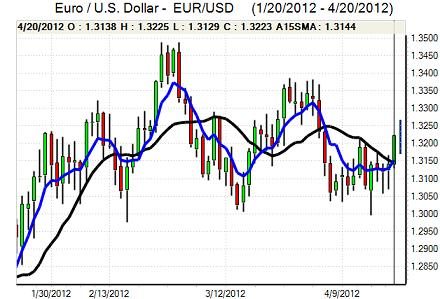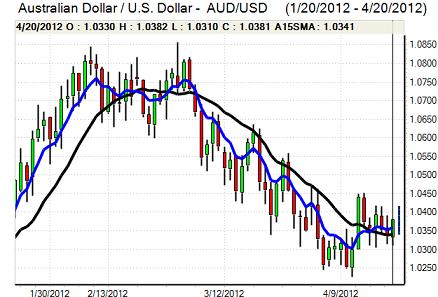EUR/USD
The Euro held above 1.31 support in Europe on Friday with sellers initially unable to drive the currency lower. The German IFO index edged higher to 109.9 for April from 109.8 the previous month, again beating market expectation and registering the sixth successive monthly advance. The data maintained the robust tone of German releases seen over the past few weeks and helped keep wider Euro-zone pessimism in check.
There was a decline in Spanish bond yields during the session which also helped underpin confidence, although sentiment was still extremely fragile, especially with unease surrounding the Italian economy as well.
There were further reports that the IMF would secure additional backing from the G20 countries which helped underpin wider US sentiment and there was confirmation of an additional US$400bn pledged at the meeting. There were no major US releases scheduled during the day and there was also natural caution ahead of this week’s Federal Reserve meeting. An improvement in risk appetite was important in pushing the Euro to two-month highs above the 1.32 level late in New York trading on Friday.
Exit polls suggested that Socialist candidate Hollande lead French Presidential first round. There will be concerns surrounding the taxation and Euro policies surrounding the government if Hollande wins the second round on May 6th. There were further tensions surrounding the Dutch government with a fresh risk of collapse as budget talks failed over the weekend.
The latest IMM positioning data recorded a still substantial net long dollar position despite a small reduction over the week which will tend to limit the scope for US gains. The Euro edged lower in Asia on Monday, although there were no major moves.

Source: VantagePoint Intermarket Analysis Software
Call now and you will be provided with FREE recent forecasts
that are up to 86% accurate* 800-732-5407
If you would rather have the recent forecasts sent to you, please go here
Yen
The dollar pushed to highs near 81.75 against the yen on Friday before edging back to the 81.50 area as the US currency was subjected to wider selling pressure. The yen was generally on the defensive on the crosses with the Euro pushing towards the 108 level.
There were further expectations that the Bank of Japan would relax monetary policy at the next policy meeting which reinforced a negative yen tone. The Japanese currency was also unsettled by a general improvement in risk appetite during the day.
The Chinese HSBC flash PMI index remained below the 50 level for April, maintaining unease surrounding the outlook. There was also a slightly more cautious tone surrounding the potential for additional Bank of Japan easing and the dollar dipped back towards the 81.25 area.
Sterling
Sterling held firm in early Europe on Friday and secured a fresh boost following stronger than expected UK data. There was a 1.8% increase in retail sales for March which was more than double the consensus forecasts. Sales were boosted by a jump in fuel sales and there was also a beneficial impact from favourable weather conditions. There will, therefore, be the risk of a reversal for April, but there was still a further underlying improvement in sentiment towards the UK economy which helped underpin Sterling.
There was a fresh five-month peak above 1.61 against the dollar while the trade-weighted index pushed to a 20-month high.
Although the Euro held firm during Friday, there were still expectations of defensive inflows into the UK currency, especially with continuing political tensions within the Euro-zone. The latest UK GDP data will be watched very closely for further evidence on the economy.
Swiss franc
The dollar remained generally on the defensive against the franc on Friday and dipped to test support below 0.91 during the New York session. There were no significant Euro moves against the Swiss currency as it remained trapped just above the 1.2010 level.
National Bank Chairman Jordan reiterated that the bank would reinforce the 1.20 minimum level and keep the franc cap intact with the threat of further intervention. Markets will be assessing Euro-zone banking-sector trends during the forthcoming week amid further fears over capital leakage into the Swiss currency as underlying Euro-zone tensions continue.

Source: VantagePoint Intermarket Analysis Software
Call now and you will be provided with FREE recent forecasts
that are up to 86% accurate* 800-732-5407
If you would rather have the recent forecasts sent to you, please go here
Australian dollar
The Australian dollar continued to find support on dips towards the 1.03 level against the US currency and moved towards the 1.0380 level during the New York session. An improvement in risk appetite was instrumental in pushing the Australian unit stronger.
The currency hit resistance towards 1.04 against the US dollar and retreated during Asian trading on Monday. Weaker than expected producer prices data reinforced expectations that there would be a Reserve Bank interest rate cut at the May meeting and there was also some disappointment over the Chinese PMI index which pushed the Australian dollar back towards the 1.0330 area.



